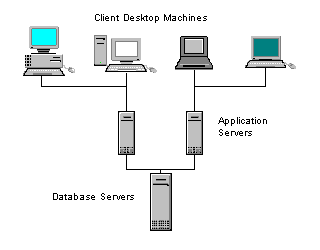1. Database:
Think of a database as a sophisticated version
of an index card file. For example, an employee phone list consists of index
cards. Each card contains employees' ID number, first name, last name, and
phone number as in the following table.
| ID_NUMBER |
FIRST_NAME |
LAST_NAME |
PHONE_NUMBER |
| 1 |
John |
Doe |
217-333-5551 |
| 2 |
Joe |
Smith |
217-343-2354 |
| 3 |
Dawn |
Pretty |
630-234-2223 |
| 4 |
Leslie |
White |
201-851-7809 |
| |
|
|
|
In database terminology, each employee's card is called a
record. Sometimes, computer programmer will call it one row. For example,
"1, John Doe, 217-333-5551" is one record or one row. All the
cards in the index card file are organized into a table. Each column of
the table stores the same type of information for all records.
Each item on a card is called a field, which is an intersection
of the row and column. A field represents two parts: field label and field
value. For example, for employee 1, John is the field value whereas the
field label is "FIRST_NAME"
A typical database is normally composed of many tables similar
to the above table. For example, in addition to the employee phone list
card file, you might also have card files for customers and products. You
can store the additional card files as additional tables in the same database.
2. Role of Database Management System (DBMS):
Data can be important asset and become useful information for an organization
only if they are organized and presented in a meaningful way. Generally,
a typical database management system (DBMS) will have the following roles.
- Data storage: The system should be able store data efficiently, safely
and securely. In most cases, corporate data are stored in a central location
for even a global organization.
- Access: The database can be accessed by employees and customers of the
organization any time and any where. Generally, concurrent access by many
users is a major advantage of modern distributed/networked database system,
in contrast to desktop database such as Microsoft Access.
- Transaction: Authorized employees or customers should be able to input
or update data into database for any operations. This requirement generally
imposes a major challenge to database system design. For example, if there
are more than one customers want to buy the same items, the database will
allow only one customer to proceed before another one. In this way, all
customers will have up-to-second information.
- Bookkeeping: The database system will keep a record of transaction and
changes in the database. If needed, a transaction can be rolled back if
necessary (similar to undo function on Microsoft WORD).
- Backup and Recovery: In case of system crash, the database system will
protect the data or recover the data loss as much as possible.
- Performance: The database responds to users' needs as quickly as possible.
- Security: Data is a major asset of any organization. No unauthorized
access or tempering will be allowed in the system.
3. Enterprise Database Management System:
Enterprise DBMS normally refers to the database system
for a typical organization. This organization may be either a business entity
such State Farm Insurance, or comprehensive operation such as Motorola.
All those organizations have needs to manage their information assets including
human resources, financial transaction and records, inventory control, customer
relationship management and many others. A typical enterprise DBMS is utilized
to handle B2C (business to customer) and B2B (business to business) applications.
A typical enterprise DBMS is configured on three-tie architecture as
in the following figure.

A user will initiate user-process request from desktop machine
which can be either a client site or through Internet. The client request
will be sent to application servers where database application programs
such as Oracle Forms reside. The application server will communicate will
the database server where all enterprise data are centrally managed.
In terms of hardware, client sites can utilize desktop or laptop PCs.
Most application servers are handled by NT servers which are able to handle
most of network traffics. Database servers typically requires high performance
and speed, most of which reside in UNIX environment. As we move from clients
to database servers, the number of machines decreases while the performance
requirement increases.
Two database administrators (DBA) went for hunting. After some careful
planning and patient waiting, they shot a large moose. They were dragging
the animal back to their truck. A colleague of theirs happened by and
said, "I do not want to tell you what to do, but it will be a whole
lot easier if you drag the moose in the other direction so that the antlers
do not dig into the ground."
After their colleague left, the two DBAs decided to try it his way. After
a while, one said to the other, "Man, that guy was totally right.
This is easier."
"Yeah, " the other replied, "but we keep getting farther
and farther away from the truck."
|